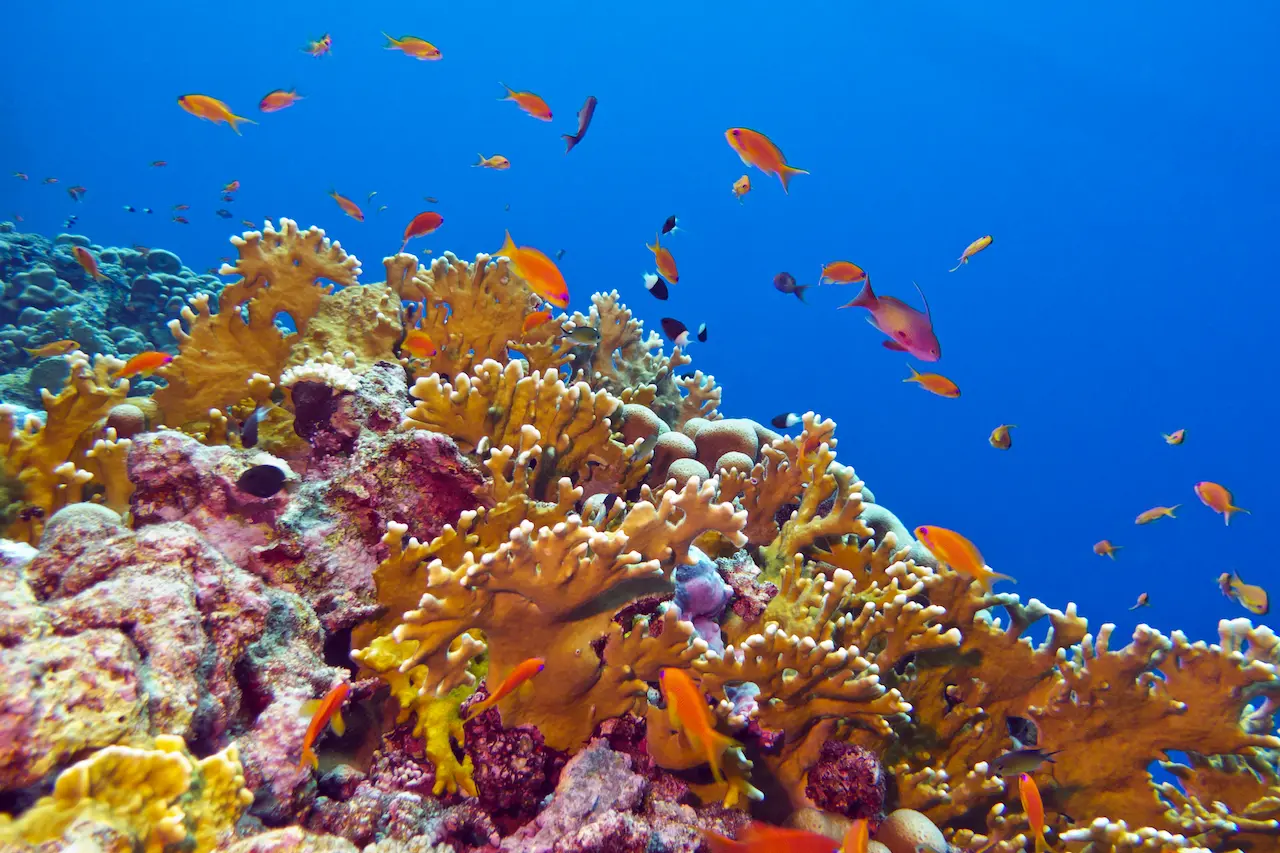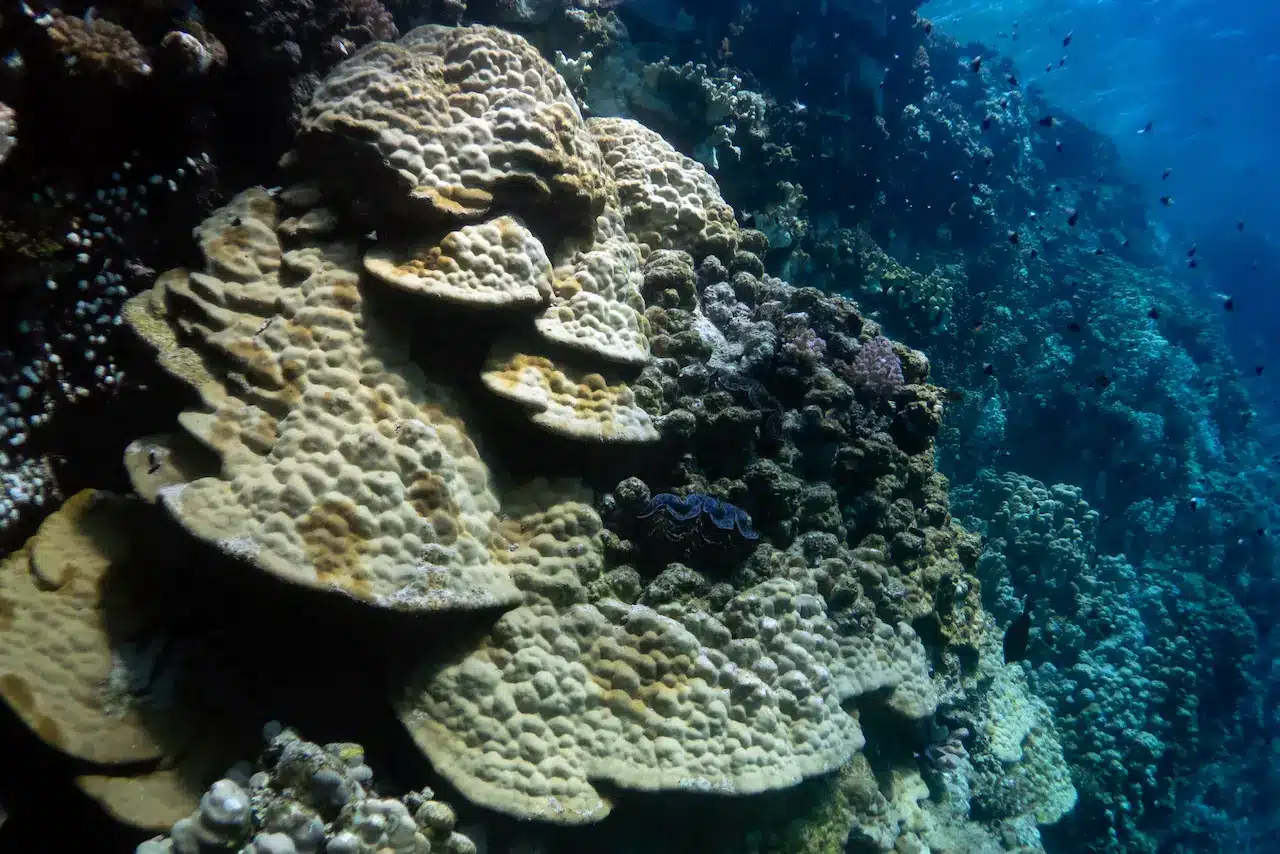Coral reefs are one of the most diverse and valuable ecosystems on Earth. They support over 25% of all marine life and provide food, income, and protection to hundreds of millions of people worldwide.
However, coral reefs are under threat from a process known as coral bleaching, where corals lose their colour and turn white when stressed by high temperatures.
Up to 95% of corals can die during a bleaching event. With climate change causing oceans to warm, mass coral bleaching events are becoming more frequent and severe. But there is hope. Here’s an in-depth look at how we can save coral reefs from bleaching.
Table of Contents
ToggleHow Can Coral Come Back from Bleaching?: Save Coral Reefs From Bleaching
Corals can recover from mild bleaching if the stressors are removed in time. Here are the ways corals can bounce back after a bleaching event:
Reducing Stressors
The first step is to reduce or eliminate the stressors that caused bleaching in the first place. This means addressing threats like climate change, pollution, overfishing, and unsustainable coastal development. Things like limiting global temperature rise, reducing agricultural runoff, establishing marine protected areas, and better managing tourism activities can give corals the breathing room they need to recover.
Specifically, to reduce climate change stress, nations worldwide must take bold action to transition from fossil fuels to renewable energy sources like solar, wind, and hydropower. Putting a price on carbon emissions through mechanisms like carbon taxes or cap-and-trade systems will also incentivise businesses and individuals to pollute less.
Improving energy efficiency in buildings, vehicles, and appliances is another important step to curb emissions. Funding research into climate-friendly technologies and nature-based solutions like reforestation can further mitigate warming.
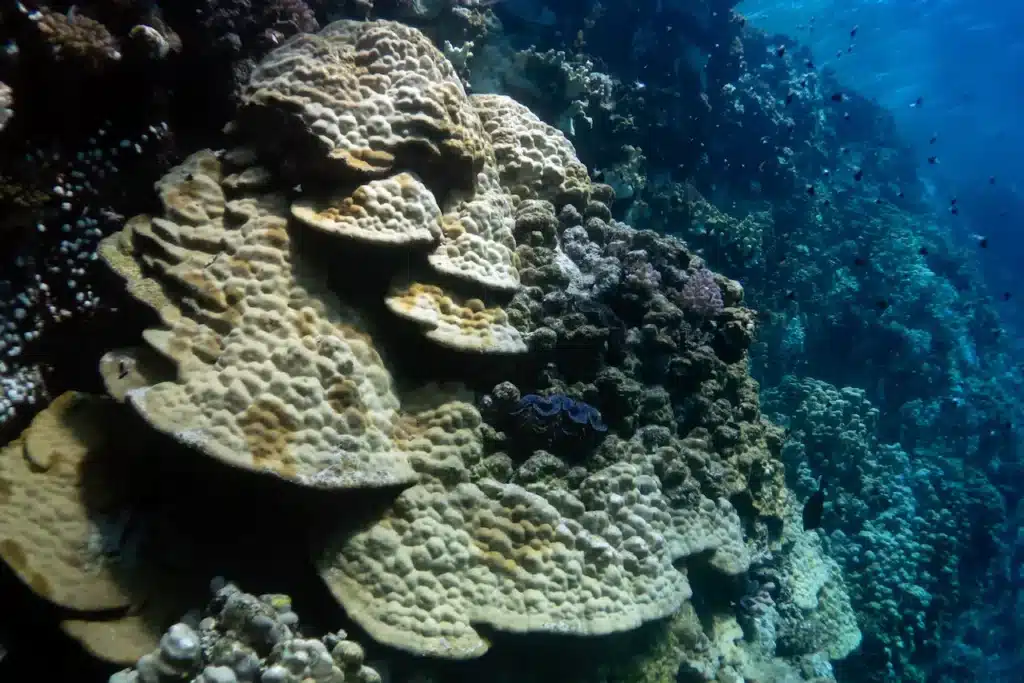
Symbiotic Algae Recolonisation
If temperatures cool down enough, the corals that survived can regain their colourful algae symbionts, which provide them with food. Given enough time, the algae populations can rebuild within the coral tissue, helping it regain strength and colour. Supporting natural algal growth through things like algae nurseries can accelerate recolonisation.
There are over 100 species of symbiotic algae called zooxanthellae that partner with coral. The specific algal species a coral hosts can influence its bleaching tolerance. Assisting the recolonisation process with algal species naturally resilient to heat stress can give the recovering corals an advantage. Identifying hardy algal strains from corals that resisted bleaching can enable targeted reintroduction efforts.
You may also like: Protecting Coral Reefs
Coral Recruitment
New baby corals can also help bleached reefs recover. Coral spawns millions of times per year, sending their larvae out to settle on hard surfaces and start new colonies. Protecting surviving corals to serve as breeding stocks produces larvae that can repopulate dead areas if conditions improve. Artificial substrates can also augment natural recruitment.
Bleaching events tend to affect large, old coral colonies, while smaller juvenile ones often fare better. Allowing these recruits to grow undisturbed provides the next generation that can potentially withstand warmer and more acidic oceans. Establishing marine protected areas limits physical disturbance and supports recruitment.
Installing calcium carbonate substrates like limestone blocks near recovering reefs creates additional surfaces for coral larvae to attach and grow on. 3d-printed ceramic and concrete artificial reef modules offer another recruitment enhancement option. Carefully designing the physical traits of these artificial structures, like texture and overhangs, promotes coral settlement.
Assisted Evolution
Research into selectively breeding more temperature-tolerant corals provides another avenue for reef recovery. Identifying corals that bleached less or recovered quicker allows for developing more resilient lineages better adapted to handle warm waters. Outplanting these “supercorals” onto damaged reefs is a proactive strategy.
Assisted evolution works by amplifying the natural selection process that corals already undergo in response to environmental pressures. Scientists identify coral colonies that show desirable traits like increased heat tolerance through a stringent selection process. These corals are then bred together in land-based coral nurseries to produce offspring with enhanced genetics.
Developing more heat-resistant coral strains through selective breeding will likely take years. But the rewards could allow reefs to better withstand marine heatwaves. The corals can be outplanted to create genetically enhanced nurseries on recovering reefs. Over time, they can sexually reproduce and spread their resilient genes to the wider ecosystem.
Can we save coral reefs?
Yes, there are proven strategies and emerging technologies that give hope that coral reefs can be saved:
Reduce Carbon Emissions
The long-term outlook for corals depends on tackling climate change. Transitioning to renewable energy and lowering carbon emissions reduces the heat stress and acidification that coral reefs face. Keeping global warming under 1.5°C gives coral the best chance to survive in the future.
To meet this goal, carbon pricing mechanisms like taxes or cap-and-trade systems need large-scale implementation to incentivise businesses and individuals to cut emissions. Phasing out fossil fuel subsidies and investing more in clean energy infrastructure are also critical steps.
Improving energy efficiency standards for buildings and transportation networks can curb emissions. Funding research and development of innovative low-carbon technologies will further support the transition.
Improve Water Quality
Reducing land-based pollution like nutrients, chemicals, and sediment through better land management and regulations improves coral resilience. Limiting coastal development and agricultural runoff are key steps.
For coastal areas, improving sewage and solid waste management to prevent nutrient runoff is a must. Constructing wetlands and biofilters allows for natural water purification. Implementing nutrient management programs for farmers through incentives and regulations also reduces fertiliser overuse. Soil conservation practices like no-till farming help retain sediments on land. Legislation to control industrial discharges and plastic usage can lessen chemical pollution.
Coastal habitats like mangroves, seagrass meadows, and salt marshes act as natural buffers that filter and trap pollution before it reaches reefs. Their conservation and restoration create an added line of defence to improve water quality. Limiting shoreline development preserves these habitats while minimising erosion and sedimentation.
Sustainably Manage Fisheries
Overfishing and destructive practices diminish coral reefs. Establishing marine reserves, catch limits, size restrictions, and banning harmful methods allows fish stocks and entire ecosystems to recover and thrive.
Integrating coral reef protection into fisheries management is paramount. Designating a third of reef habitats as no-take marine reserves provides a refuge for fish to grow and reproduce unhindered while also dispersing biomass to surrounding waters.
Stronger enforcement of fishing quotas and gear restrictions further safeguards populations. Outreach programs that supply fishermen with alternative gear and facilitate cooperation are also beneficial.
Community-based management engages local stakeholders in conservation solutions while supporting livelihoods.
Formalising customary marine tenure arranges community management of traditional fishing grounds. Providing infrastructure like cold storage allows for higher-value fish sales. Sustainable aquaculture and tourism activities can supplement incomes while easing harvesting pressure.
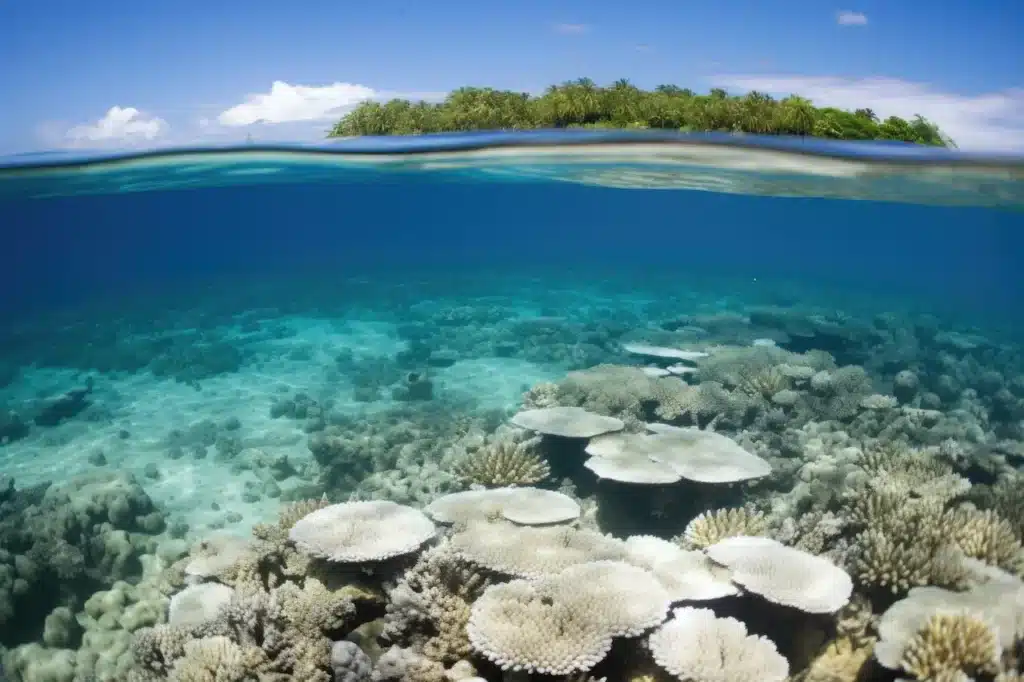
Restore Damaged Reefs
Active restoration through coral gardening, substrate installation, and assisted evolution helps bring degraded reefs back from the brink. Identifying priority areas and tailoring methods to local needs expands recovery efforts.
A holistic mapping approach combining on-the-ground surveys with aerial imaging identifies which damaged reef areas have the best shot at successful restoration. Sites still connected to healthy reefs or with native coral remaining usually offer the greatest recovery potential and can become focal points for active regeneration efforts.
Installing coral nurseries directly on damaged reefs provides on-site stock for ecosystem recovery. Utilising more resilient corals bred to handle local conditions gives the greatest survival likelihood after outplanting. Taking care to mimic surrounding coral density and diversity during transplantation minimises disruption.
You might also like: What Is A Coral Reef?
Assisted Evolution
Selective breeding and genetic modification produce coral variants with increased heat tolerance and disease resistance. Lab-based acceleration of natural evolutionary processes better equips reefs to handle warming oceans.
While a controversial strategy, assisted evolution through selective breeding or gene editing has the potential to rapidly develop coral strains resilient to both warming and disease.
Conventional breeding approaches involve controlled crosses between corals with desirable traits like heat tolerance, which are then outplanted onto reefs. This allows natural selection to further hone their environmental fitness.
More direct genetic engineering using CRISPR gene editing can potentially introduce targeted modifications to boost thermal tolerance. However, the ecological effects of releasing such organisms would need extensive testing before considering field application.
Protect Existing Reefs
Establishing marine protected areas limits direct human damage to reefs from activities like fishing, dredging, and anchoring. Reducing threats gives coral the space and resources to be more resilient.
Marine reserves are zones designated to fully protect coral reef habitats while restricting extractive uses. They provide undisturbed refuges where coral can thrive. Studies show reserves effectively protect fish stocks and boost ecosystem health. Expanding their extent and stepping up enforcement safeguards in existing coral strongholds.
No-anchoring zones prevent physical reef destruction from ships anchoring on coral. Public moorings provide alternative docking points. Restricting coastal development preserves natural buffers against sediment and pollution. Banning dredging and trawling also reduces reef damage. Such protections need large-scale implementation.
Improve Governance
Legislation and policies are needed at the local and global levels. Government support enables conservation funding, habitat protections, climate action, and the enforcement of regulations that protect reefs.
Strengthening environmental laws and passing new policies provide the regulatory levers to implement coral conservation strategies, from fisheries limits to pollution controls to marine reserves.
Adequately funding management agencies allows for proper oversight and enforcement. Mainstreaming coral ecosystem services into policy decisions further prioritises protection.
At the international level, all countries must uphold commitments to climate change mitigation and conservation funding targets to enable local reef safeguarding efforts. Regional cooperation facilitates information sharing and joint management of resources like migratory fish stocks. Engaging indigenous groups and other stakeholders promotes equity and compliance.
Can coral bleaching be reversed?
Yes, coral bleaching can be reversed if caught in time and corrective actions are taken quickly:
Reduce the Stressors
The priority is alleviating whatever is causing the coral to bleach. This might mean shading corals during heatwaves, improving water circulation, or stopping any mechanical damage from happening to the reef. Reducing stress is key for recovery.
If bleaching is temperature-driven, emergency cooling measures help lower the thermal strain. This can involve pumping cooler deep water onto reefs, deploying wind-driven upwelling systems, or spraying fine seawater to create a cooling mist. Providing temporary shade with tarpaulins or floating screens also cools water.
Reducing pollution and sedimentation stress through deploying silt screens or water filters improves water quality. Halting destructive activities like dredging prevents further physical disturbances. Quick action to stabilise conditions gives coral the best survival chances.
Cool Down the Reef
Lowering temperatures gives bleached coral the best chance to regain their algae symbionts. Strategies include pumping cooler deep water onto reefs or spraying fine water to create a cooling mist. Provide shade using tarps or floating screens.
Cooler water reverses the thermal stress reaction that causes the coral to expel its algae. Pumping water from deep ocean layers through pipes or lifting colder undercurrents with turbine systems counteracts warming at the surface. Creating cooling mists through atomiser nozzles or fountain systems also helps lower temperatures.
Shading hardware like floating screens absorbs solar radiation before it warms the water. Canvas tarps or bamboo shades are low-cost, temporary shading options. Careful placement and monitoring of cooling systems are needed to cover key coral areas without disrupting water flow or light levels.
Assist Algal Recolonisation
Algae populations rebuilding within the coral tissue are vital. Fragments of coral with algae still intact can be transplanted near bleached corals to help jumpstart recolonisation. Algae nurseries can also populate reefs when conditions improve.
Transplanting small coral fragments with symbiotic algae from nearby unbleached reefs helps speed algal return. The remaining algal cells multiply and spread to bleached corals either through water currents or direct coral-to-coral transmission. Verifying algal strains are compatible with the recipient species optimises success.
Off-site algae nurseries can mass-produce coral with high algal densities for transplantation when bleaching subsides. Growing donor coral under controlled conditions with cool water allows for maximising algal growth. Periodic health checks track algal repopulation progress.
Reduce Pathogens
Bleaching leaves corals vulnerable to deadly bacterial infections. Using antibiotics and algae extracts helps control pathogens. Quarantining and removing infected pieces may be needed to stop disease spread.
Diseased coral requires treatment with specially formulated antibiotics to inhibit bacterial growth. Extracts from native algae have also shown antimicrobial properties when applied to infected coral tissues. Strict hygiene protocols prevent transmission between treatment tanks.
Severely infected fragments beyond recovery should be removed and destroyed to prevent pathogen spread. Periodic disinfection of remaining coral may also be required using chlorine treatments or UV irradiation of water. Strict controls are critical for managing coral disease outbreaks.
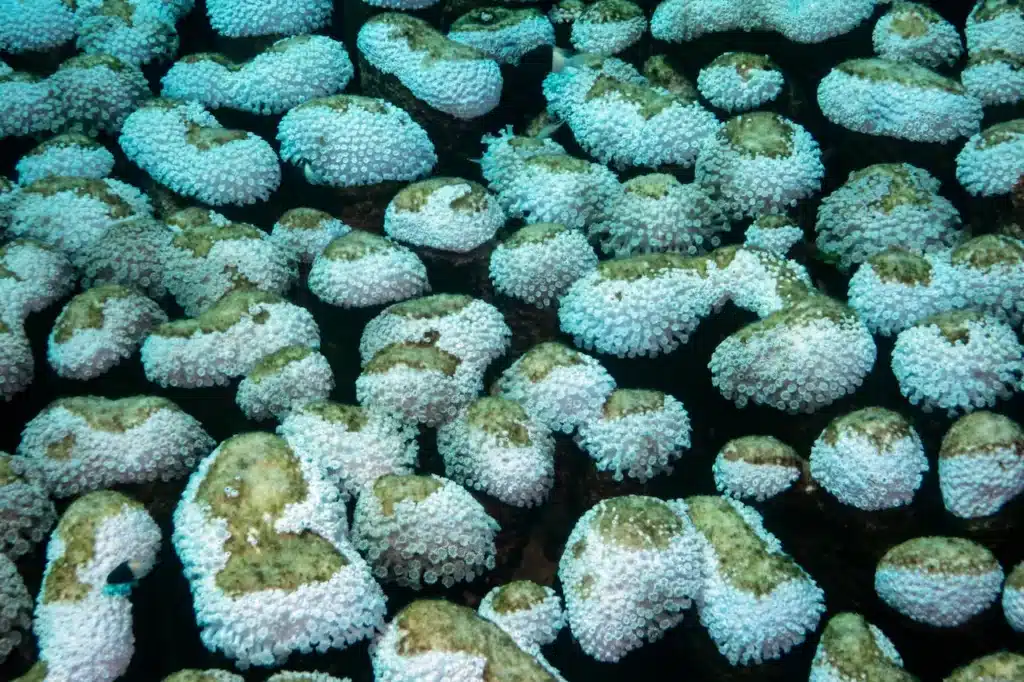
Supportive Care
Tending to corals in underwater nurseries until they regain their algae allows them to recover under controlled conditions. Providing supplemental feeding optimises their growth during recovery.
Coral nurseries with enclosed, shaded structures allow nursery-raised coral to regain algal symbionts in an ideal low-stress setting. Daily feeding with plankton or amino acid solutions provides the needed nutrition normally supplied by algae. Regular monitoring tracks health status until algae return and colony strength stabilises.
Maintaining optimal water quality through filtration, disinfection, and temperature control supports recovery. Concrete, PVC pipe, or rope nursery structures allow easy coral fragment attachment and relocation. Meticulous husbandry gives corals the best shot at resuming normal growth.
Monitor Progress
Observe corals closely to see if they are regaining colour and stabilising. Take tissue samples to check the algal density. Have divers perform health checks and treat any emerging issues immediately.
Frequent visual inspections note colour improvement and tissue thickening as signs that algae are recolonising and coral health is restored. Microscope analysis of tissue samples monitors symbiotic algal densities, which rise as recovery progresses. Photographic monitoring documents change over time.
Trained divers conduct hands-on health checks, sampling affected corals to test for pathogens and spot-treat any lesions. Early intervention for setbacks improves outcomes. Recovery can take months, requiring diligent monitoring and adaptive care.
Be Patient
It takes time for coral to recover from severe bleaching, even with intervention. Months may be needed for algal densities and colour to return to normal levels. Sustained care and protection are essential during the recovery process.
Severe bleaching events can require a year or more for coral communities to bounce back, even with extensive human assistance. Some mortality is likely, given the extent of physiological damage. Returning even a fraction of affected reefs to ecological health represents a major success.
Conclusion
Coral reefs around the world have suffered from repeated bleaching events over the past few decades. But hope remains to save these valuable ecosystems if we take prompt collective action. Following the steps outlined here, from local reef management to international climate cooperation, can help coral reefs survive into the future. With ongoing care and commitment, we can preserve coral reef biodiversity, ecological services, and natural splendour for generations to come. But action is urgent – the window to secure coral reef futures is rapidly closing. By working together on multiple fronts, we can give coral reefs their best chance against the threats they face. If we act now, coral reefs can continue to thrive.

